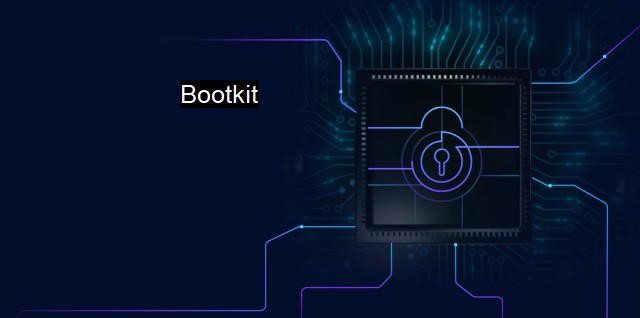What is Bootkit?
The Threat of Bootkits: Understanding Their Definitions, Risks, and Detection Techniques in Modern Antivirus Software
In understanding the cyber vulnerabilities that exist today, bootkits represent a segment of an ever-evolving technological landscape. Bootkits have emerged as potent threats in the realm of cybersecurity that utilize sophisticated technology to disrupt, corrupt, or steal information from targeted systems. They are essentially a type of rootkit that infects the Master Boot Record (MBR), a crucial part of any system that helps to load the operating system. Cybersecurity professionals consider bootkits as one of the most lethal types of rootkits considering the deep access level they possess, and how stealthy they can be.To fully grasp what a bootkit is, it is important first to comprehend the notion of rootkits. Rootkits are a collection of software or programs designed by hackers to gain control over a system without being detected by the system users or the security software installed. They can gain access to sensitive or confidential data, modify system configurations, or introduce more malicious software—all in stealth mode.
Bootkits are a subclass of rootkits, designed to attack computers at the system's booting process. It involves malicious code attaching itself to the MBR (Master Boot Record). Once infected, every system restarting or boot-up process begins with the bootkit. During this process, the bootkit can bypass all security measures, gaining an unfair advantage over many of the advanced antivirus software deployed.
To clarify, the MBR is a vital part of any computer system. When a computer is initiated, the BIOS or Basic Input/Output System is activated. The BIOS then locates the system's primary boot device and loads the first sector into memory, which is where the MBR is located. The MBR is responsible for loading and executing the partition boot code.
Bootkits are especially dangerous because the MBR operates at a lower level than antivirus software and other security systems built into the device's operating systems. This means that once a bootkit infiltrates this level, it becomes superlatively challenging to locate and eradicate. It can disguise itself, launch other malicious software, circumvent detection, and recovery, keeping the system within its grip.
The use of bootkits in cyber-attacks has resulted in significant damage in both private and public sectors worldwide. For instance, Mebromi, a type of bootkit, focused on attacking systems with specific BIOS types and has proven to be devastatingly effective. Its capability to bypass administrative rights makes it difficult to cleanse the infected system thoroughly.
The manufacturing of bootkits is a complicated process requiring in-depth knowledge and skills as bootkits operate at a high privilege level (kernel-mode), exploiting vulnerabilities present in the system's bootloader or the BIOS firmware. Because of this, combatting bootkits requires specialized tools which can scan for suspicious activity in the MBR, unusual drivers, or hidden processes.
Antivirus companies are actively working on strategies to counter the mounting threat of bootkits. Traditional antivirus methods are augmented with specific bootkit screening facilities that can detect such threats on multiple OS levels. Some antivirus programs also leverage virtualization to prevent bootkits from attaching themselves to the MBR before the operating system boots.
Whether it is fixing vulnerabilities present in software, educating consumers on practising safe computing, or cooperating with government bodies to track down offenders, actions are continuously pursued to reach a cyber-threat-free space.
While technology continues to evolve, so does malicious software and techniques. Bootkits represent one such potent threat in cybersecurity. Therefore, robust solutions and strict vigilance are prerequisites to gain the upper hand in the battle against bootkits and other similar forms of rootkits.

Bootkit FAQs
What is a Bootkit?
A Bootkit is a type of malware designed to infect the master boot record (MBR) of a computer's hard drive. It allows the malware to gain control of the operating system before it boots up, making it difficult for antivirus software to detect and remove.How does a Bootkit work?
A Bootkit works by replacing or modifying the legitimate boot loader in the MBR with its own malicious code. When the system boots up, the malware is executed before the legitimate operating system, giving it control over the system. This allows the malware to hide itself and any other malicious processes from detection by antivirus software, making it a potent threat.How can I protect my computer against Bootkits?
To protect your computer against Bootkits, you should keep your antivirus software up to date and regularly scan your system for malware. You should also be cautious of downloading and installing software from untrusted sources, as this can often be a common way for Bootkits to infect your system. Additionally, using an encrypted boot loader or enabling secure boot can also help to protect against Bootkits.What are some signs that my computer may be infected with a Bootkit?
Some signs that your computer may be infected with a Bootkit include slow system performance, unexplained crashes or freezes, unusual error messages, and changes to your system settings that you did not make. Your antivirus software may also alert you to the presence of a Bootkit, but as they are designed to evade detection, you may not always receive a warning.| | A | | | B | | | C | | | D | | | E | | | F | | | G | | | H | | | I | | | J | | | K | | | L | | | M | |
| | N | | | O | | | P | | | Q | | | R | | | S | | | T | | | U | | | V | | | W | | | X | | | Y | | | Z | |
| | 1 | | | 2 | | | 3 | | | 4 | | | 7 | | | 8 | | |||||||